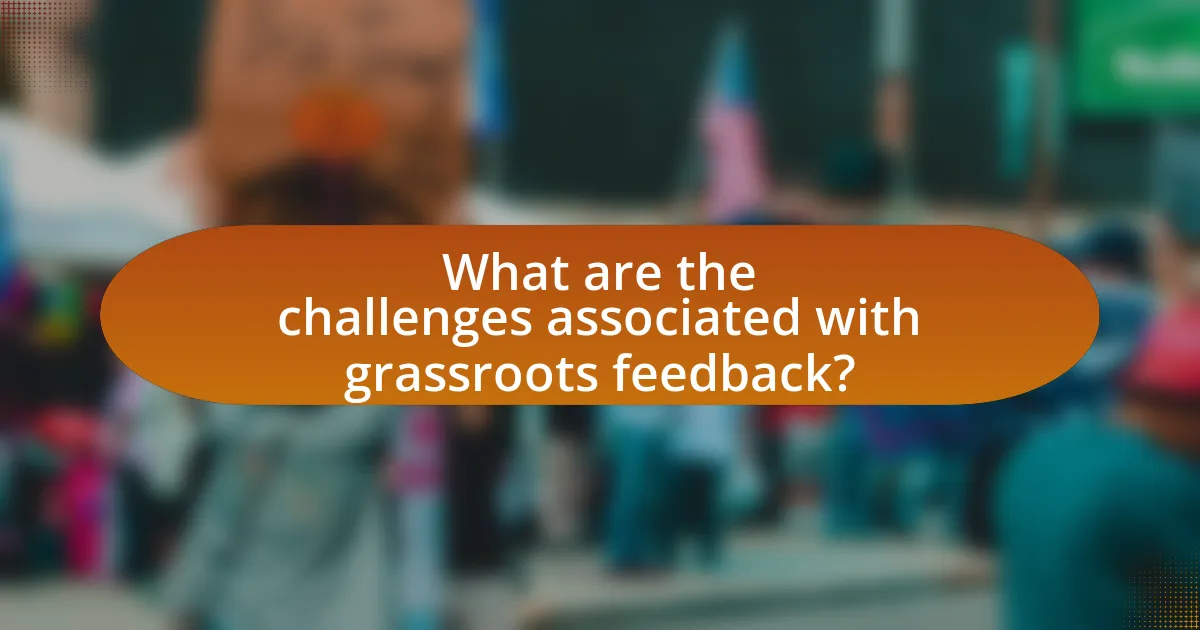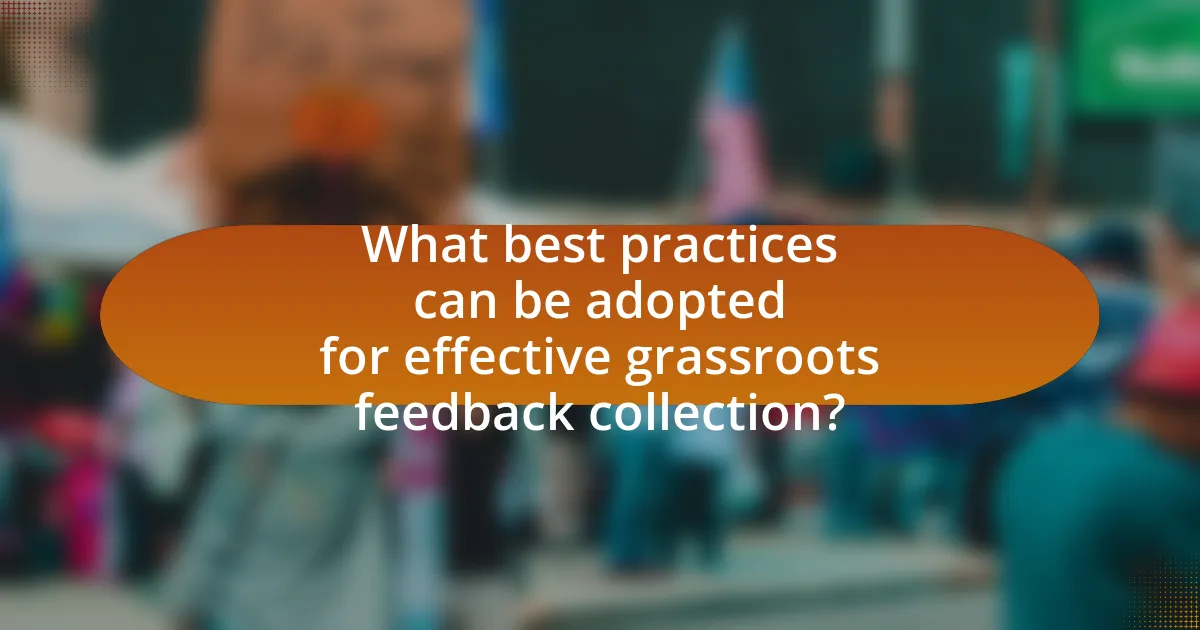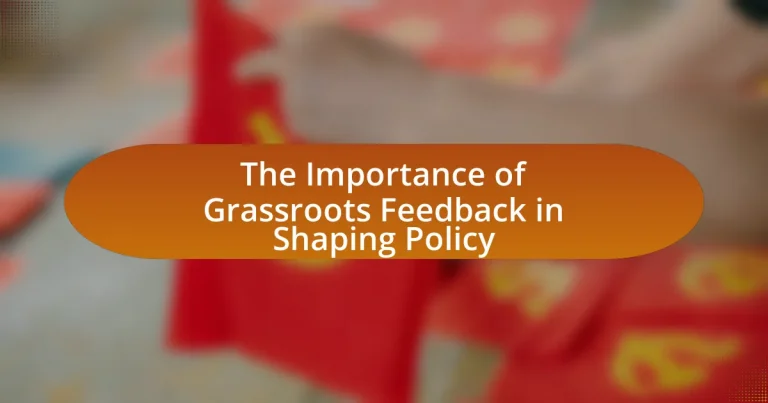The article focuses on the critical role of grassroots feedback in shaping policy, emphasizing its importance in reflecting community needs and concerns. It outlines how grassroots feedback influences decision-making processes, enhances public trust in government, and leads to more effective governance. The article also discusses mechanisms for collecting feedback, the challenges associated with it, and strategies to mitigate bias, ensuring inclusivity in feedback processes. Additionally, it highlights the impact of technology on grassroots engagement and the necessity of continuous feedback loops for improving policy outcomes.

What is the role of grassroots feedback in shaping policy?
Grassroots feedback plays a crucial role in shaping policy by providing direct insights from the community that reflect the needs and concerns of the population. This feedback informs policymakers about the real-world implications of their decisions, ensuring that policies are more relevant and effective. For instance, studies have shown that when local communities engage in the policy-making process, the resulting policies are more likely to address specific local issues, leading to improved public satisfaction and outcomes. Additionally, grassroots movements have historically influenced significant policy changes, such as the civil rights movement, which demonstrated how collective community voices can lead to legislative reforms.
How does grassroots feedback influence decision-making processes?
Grassroots feedback significantly influences decision-making processes by providing direct insights from the community, which decision-makers can use to align policies with public needs. This feedback often highlights specific issues that may not be visible at higher levels of governance, ensuring that decisions are informed by the lived experiences of constituents. For instance, studies have shown that when local governments incorporate community input, they can improve service delivery and increase public trust, as evidenced by the success of participatory budgeting initiatives in cities like Porto Alegre, Brazil, where citizen engagement led to more equitable resource allocation.
What mechanisms facilitate the collection of grassroots feedback?
Mechanisms that facilitate the collection of grassroots feedback include surveys, community forums, social media platforms, and participatory budgeting processes. Surveys allow for structured data collection from a wide audience, while community forums provide a space for open dialogue and discussion among stakeholders. Social media platforms enable real-time feedback and engagement, allowing grassroots voices to be amplified. Participatory budgeting processes involve community members in decision-making, ensuring their input directly influences resource allocation. These mechanisms are effective as they create accessible channels for individuals to express their opinions and experiences, thereby enhancing the responsiveness of policy-making to community needs.
How is grassroots feedback integrated into policy formulation?
Grassroots feedback is integrated into policy formulation through mechanisms such as public consultations, surveys, and community engagement initiatives. These methods allow policymakers to gather insights directly from the affected communities, ensuring that their needs and perspectives are considered in the decision-making process. For example, the World Bank emphasizes the importance of participatory approaches, stating that involving citizens in policy discussions leads to more effective and relevant outcomes. This integration of grassroots feedback not only enhances transparency but also fosters trust between the government and the community, ultimately resulting in policies that are more aligned with the public’s interests.
Why is grassroots feedback essential for effective governance?
Grassroots feedback is essential for effective governance because it provides direct insights from the community, ensuring that policies reflect the actual needs and concerns of the populace. This feedback mechanism fosters accountability, as it allows citizens to voice their opinions and influence decision-making processes. Research indicates that governments that actively engage with grassroots feedback tend to implement more relevant and successful policies, as evidenced by the World Bank’s findings in their 2017 report, which highlighted that participatory governance leads to improved public service delivery and increased citizen satisfaction.
What are the potential consequences of ignoring grassroots feedback?
Ignoring grassroots feedback can lead to significant misalignment between policy decisions and the actual needs of the community. When policymakers overlook input from grassroots movements, they risk implementing solutions that do not address the real issues faced by constituents, resulting in ineffective policies. For instance, a study by the National Civic League found that communities that actively engage with grassroots feedback experience higher levels of civic trust and better policy outcomes. Additionally, ignoring such feedback can foster disillusionment and disengagement among community members, ultimately undermining democratic processes and leading to social unrest.
How does grassroots feedback enhance public trust in government?
Grassroots feedback enhances public trust in government by fostering transparency and accountability. When citizens actively participate in providing feedback, it creates a direct line of communication between the government and the public, allowing for concerns and suggestions to be addressed promptly. This engagement demonstrates that the government values the opinions of its constituents, which can lead to increased satisfaction with governmental actions. Research indicates that communities with higher levels of civic engagement, such as those utilizing grassroots feedback mechanisms, report greater trust in their local governments, as seen in studies conducted by the National Civic League.

What are the challenges associated with grassroots feedback?
Grassroots feedback faces several challenges, including limited representation, potential bias, and difficulties in data collection. Limited representation occurs when feedback is gathered from a small or unrepresentative sample of the community, leading to skewed insights that may not reflect the broader population’s views. Potential bias can arise from the influence of dominant voices within grassroots movements, overshadowing minority opinions and creating an incomplete picture of community needs. Additionally, difficulties in data collection stem from logistical issues, such as reaching diverse populations and ensuring that feedback mechanisms are accessible and user-friendly, which can hinder the effectiveness of grassroots feedback initiatives.
How can biases affect the collection of grassroots feedback?
Biases can significantly distort the collection of grassroots feedback by influencing who is heard and how their input is interpreted. For instance, confirmation bias may lead facilitators to prioritize feedback that aligns with their pre-existing beliefs, thereby neglecting diverse perspectives. Additionally, social desirability bias can cause respondents to provide answers they believe are more acceptable rather than their true opinions, skewing the data collected. Research indicates that these biases can result in a misrepresentation of community needs, ultimately affecting policy decisions. A study by the National Academy of Sciences highlights that biased feedback mechanisms can lead to ineffective policies that do not address the actual concerns of the community.
What strategies can mitigate bias in grassroots feedback?
To mitigate bias in grassroots feedback, employing diverse feedback channels is essential. Utilizing multiple platforms, such as surveys, focus groups, and community forums, ensures a broader representation of voices and perspectives. Research indicates that diverse input can reduce the influence of dominant narratives, as seen in studies where varied demographic participation led to more balanced outcomes in community decision-making processes. Additionally, implementing anonymous feedback mechanisms can encourage honest responses, further minimizing bias. This approach has been validated by findings from the National Civic League, which highlight that anonymity in feedback collection often results in more candid and varied input, thus enhancing the overall quality of grassroots feedback.
How do socio-economic factors influence grassroots feedback?
Socio-economic factors significantly influence grassroots feedback by shaping the perspectives and priorities of community members. Individuals from varying socio-economic backgrounds experience different challenges and opportunities, which directly affect their engagement and the issues they prioritize in feedback mechanisms. For instance, lower-income communities may focus on immediate needs such as housing and healthcare, while higher-income groups might prioritize education and infrastructure. Research by the Pew Research Center indicates that socio-economic status correlates with civic engagement levels, where individuals with higher education and income are more likely to participate in feedback processes. This disparity in engagement leads to a skewed representation of community needs, ultimately impacting policy decisions that rely on grassroots input.
What role does technology play in gathering grassroots feedback?
Technology plays a crucial role in gathering grassroots feedback by facilitating real-time communication and data collection from diverse populations. Digital platforms, such as social media, mobile applications, and online surveys, enable organizations to reach a wider audience quickly and efficiently, allowing for the collection of opinions and experiences that reflect community needs. For instance, a study by the Pew Research Center found that 69% of adults in the U.S. use social media, which can serve as a powerful tool for engaging citizens and gathering their insights on policy issues. Additionally, technology allows for the analysis of large datasets, helping policymakers identify trends and areas of concern within grassroots feedback, ultimately leading to more informed decision-making.
How can digital platforms enhance grassroots engagement?
Digital platforms can enhance grassroots engagement by providing accessible communication channels that facilitate direct interaction between citizens and policymakers. These platforms enable individuals to share their opinions, mobilize support for causes, and organize community actions efficiently. For instance, social media networks have been shown to increase participation in civic activities; a study by the Pew Research Center found that 69% of adults in the U.S. use social media, which can amplify grassroots movements and foster community discussions. Additionally, online petitions and forums allow for real-time feedback, ensuring that diverse voices are heard in the policymaking process. This increased accessibility and immediacy of communication can lead to more informed and responsive governance.
What are the risks of relying on technology for grassroots feedback?
Relying on technology for grassroots feedback poses several risks, including data privacy concerns, digital divide issues, and potential bias in data collection. Data privacy concerns arise as personal information may be exposed or misused, undermining trust in the feedback process. The digital divide highlights that not all community members have equal access to technology, leading to underrepresentation of certain groups in feedback. Additionally, algorithms used in data collection can introduce bias, skewing results and misrepresenting community needs. For instance, a study by the Pew Research Center found that lower-income individuals are less likely to have access to smartphones or reliable internet, which can distort the feedback landscape.

What best practices can be adopted for effective grassroots feedback collection?
Effective grassroots feedback collection can be achieved through several best practices, including establishing clear communication channels, engaging diverse community members, and utilizing technology for data collection. Clear communication channels, such as surveys and community meetings, ensure that feedback is accessible and understandable, fostering participation. Engaging diverse community members, including marginalized groups, enhances the richness of the feedback and ensures that various perspectives are represented. Utilizing technology, such as mobile apps and online platforms, streamlines the collection process and can increase response rates, as evidenced by a study from the Pew Research Center which found that 81% of Americans own smartphones, making digital feedback collection more feasible. These practices collectively enhance the effectiveness of grassroots feedback collection, leading to more informed policy decisions.
How can policymakers ensure inclusivity in feedback processes?
Policymakers can ensure inclusivity in feedback processes by actively engaging diverse community stakeholders throughout the policy development cycle. This engagement can be achieved through targeted outreach efforts, such as organizing public forums, utilizing surveys in multiple languages, and collaborating with local organizations that represent marginalized groups. Research indicates that inclusive feedback mechanisms lead to more equitable policy outcomes, as evidenced by the 2018 study published in the Journal of Policy Analysis and Management, which found that policies shaped by diverse input are more likely to address the needs of underrepresented populations effectively.
What methods can be used to reach underrepresented communities?
To reach underrepresented communities, targeted outreach methods such as community engagement initiatives, partnerships with local organizations, and culturally relevant communication strategies can be employed. Community engagement initiatives, like town hall meetings and focus groups, facilitate direct dialogue and feedback from these populations. Collaborating with local organizations, which already have established trust and rapport, enhances outreach effectiveness. Culturally relevant communication strategies, including the use of native languages and culturally appropriate messaging, ensure that information resonates with the community. These methods are supported by research indicating that inclusive engagement leads to more effective policy outcomes and increased community participation.
How can feedback be effectively communicated back to the community?
Feedback can be effectively communicated back to the community through structured channels such as community meetings, newsletters, and digital platforms. These methods allow for clear dissemination of information and ensure that community members are informed about how their input has influenced decisions. For instance, community meetings provide a forum for direct dialogue, while newsletters can summarize feedback outcomes and policy changes. Digital platforms, like social media and community websites, facilitate ongoing engagement and allow for real-time updates. Research indicates that communities that utilize multiple communication channels report higher levels of satisfaction and engagement, demonstrating the effectiveness of these methods in fostering transparency and trust.
What are the key takeaways for leveraging grassroots feedback in policy-making?
Key takeaways for leveraging grassroots feedback in policy-making include actively engaging communities to gather diverse perspectives, ensuring transparency in the feedback process, and integrating insights into decision-making. Engaging communities fosters trust and encourages participation, as evidenced by the success of participatory budgeting initiatives in cities like Porto Alegre, Brazil, where citizen input led to more equitable resource allocation. Transparency in how feedback is collected and utilized enhances accountability, as seen in the Open Government Partnership, which promotes citizen involvement in governance. Finally, integrating grassroots insights into policy decisions leads to more effective and relevant policies, supported by research indicating that policies informed by community feedback are more likely to meet the needs of the population they serve.
How can continuous feedback loops improve policy outcomes?
Continuous feedback loops can significantly improve policy outcomes by ensuring that policymakers receive real-time insights from stakeholders, allowing for timely adjustments and enhancements. This iterative process enables the identification of issues and the incorporation of diverse perspectives, which leads to more effective and responsive policies. For instance, research conducted by the Stanford Social Innovation Review highlights that organizations employing feedback mechanisms saw a 30% increase in stakeholder satisfaction and a 25% improvement in policy effectiveness. By integrating continuous feedback, policies can evolve based on actual experiences and needs, ultimately fostering greater accountability and transparency in governance.
What steps can be taken to foster a culture of feedback in governance?
To foster a culture of feedback in governance, organizations should implement structured feedback mechanisms, such as regular surveys and town hall meetings, to encourage open communication. These mechanisms allow citizens and stakeholders to voice their opinions and experiences, which can directly influence policy decisions. Research indicates that participatory governance models, which actively seek input from the community, lead to more effective and responsive policies. For instance, a study by the World Bank found that countries with higher levels of citizen engagement in governance processes tend to have better public service outcomes. By prioritizing transparency and accountability, governance bodies can create an environment where feedback is valued and acted upon, ultimately enhancing democratic processes and policy effectiveness.


